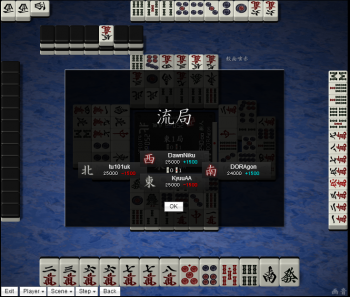Ryuukyoku: Difference between revisions
m (Note exceptions) |
No edit summary |
||
| Line 5: | Line 5: | ||
[[Jikaze|Wind seating]] may or may not occur depending on the [[oya|dealer's]] hand. If the dealer is tenpai, then the wind seating does not rotate; and on the other hand, wind seating does rotate if the dealer fails to develop a tenpai hand. Though rules may be modified to require the dealer to win the hand, rather than just simply attaining tenpai. | [[Jikaze|Wind seating]] may or may not occur depending on the [[oya|dealer's]] hand. If the dealer is tenpai, then the wind seating does not rotate; and on the other hand, wind seating does rotate if the dealer fails to develop a tenpai hand. Though rules may be modified to require the dealer to win the hand, rather than just simply attaining tenpai. | ||
While the term "ryuukyoku" is usually used to refer to an exhaustive draw in Japanese, on occasion this may be ambiguous, as the term technically refers to any draw (cf. [[tochuu ryuukoku]], {{kana|途中流局}}). When ambiguity occurs, it may be referred to as '''tsuujau no ryuukyoku''' {{kana|通常の流局}}, which translates roughly as "usual kind of draw". | |||
==Tenpai== | ==Tenpai== | ||
Revision as of 19:06, 11 March 2015

Ryuukyoku 「流局」 is also known as an exhaustive draw. Sometimes, all the tiles aside from the dead wall are drawn, and no player manages to produce a winning hand. In this case, players in tenpai reveal their hands and receive points from those in noten (players not in tenpai). Players in noten may choose to reveal their hands, but it is not required. Noten hands do not affect the point exchanges, when revealed. Though, players in tenpai are not particularly required to reveal their hands. Instead, they may opt to declare noten, despite having a tenpai hand. In exchange for keeping the hand hidden, a player loses points.
Nearly 40% of professional games go to an exhaustive draw due to players immediately abandoning the hand when a player declares riichi.
Wind seating may or may not occur depending on the dealer's hand. If the dealer is tenpai, then the wind seating does not rotate; and on the other hand, wind seating does rotate if the dealer fails to develop a tenpai hand. Though rules may be modified to require the dealer to win the hand, rather than just simply attaining tenpai.
While the term "ryuukyoku" is usually used to refer to an exhaustive draw in Japanese, on occasion this may be ambiguous, as the term technically refers to any draw (cf. tochuu ryuukoku, 「途中流局」). When ambiguity occurs, it may be referred to as tsuujau no ryuukyoku 「通常の流局」, which translates roughly as "usual kind of draw".
Tenpai
Tenpai is the state of the hand waiting on just one tile to claim for a win, either by draw or discard. Even if the hand does not win, it can still be awarded a small amount of points at the end of the hand, after all possible tiles are drawn and discarded. So, hands at tenpai during ryuukyoku still has some value.
Point exchanges
If some players are tenpai and some are not, a total exchange of 3,000 points are evenly split between the players in tenpai players from the players in noten.
Point exchanges are as follows:
- 0 players in tenpai: No points exchanged.
- 1 player in tenpai: All players in noten pays 1,000 points to the tenpai player.
- 2 players in tenpai: Each player in noten pays 1,500 points, each player in tenpai receives 1,500 points.
- 3 players in tenpai: The single player in noten plays 1,000 points to each player in tenpai.
- 4 players in tenpai: No points exchanged.
When no players are in tenpai, then the wind seating rotates. When all players are tenpai, then the wind seating does not rotate. For the other three cases, wind rotation is dependent on the dealer being tenpai or not. When a ryuukyoku occurs, a honba is added to the count for the next hand, with two exception: when a player in riichi reveals a noten and is penalized for chombo and, in some variations of the nagashi mangan rule, when a player successfully completes nagashi mangan.
Hand progression
Often, a hand may end in a draw, where players had declared riichi. Any leftover riichi bets on the table are placed near the counters until collected by the winner of a hand. If the dealer is not in tenpai, then the seat winds rotate normally. If the dealer is in tenpai, the seat winds remain the same for the next hand.
The count for honba keeps track of the number of consecutive hands, by which no one has won a hand. Every time ryuukyou or even tochuu ryuukoku (abortive draw) occurs, this count increases by one. Barring house rules, the count may or may not increase regarding chombo. When a non-dealer player wins a hand, the count resets back to zero.
Variation
Variation on ryuukyoku stems from the qualification of tenpai. Under some rules and conditions, hands appear to be in tenpai will be declared as noten instead.
Some many consider this hand as noten, despite needing one tile for completion. So, instead of gaining points, the player loses points at ryuukyoku. The hand is also karaten, or impossible to complete. All possible tiles for completion are used with the dubious kan call.
At some point, the hand looked like this. As it stands, this hand is actually complete. The kan was closed, and no open call was made. The tiles already constitute the necessary tile groups and the pair. Therefore, the hand should have been properly called for a win or tsumo instead.
External links
- Ryuukyoku in Japanese Wikipedia